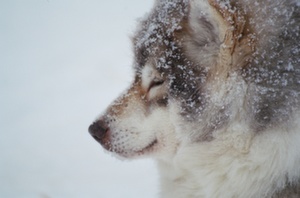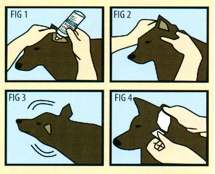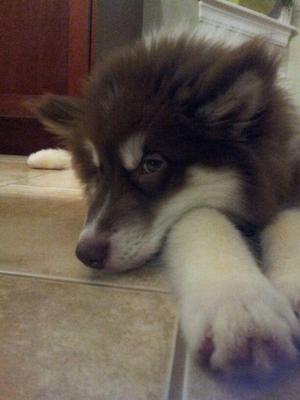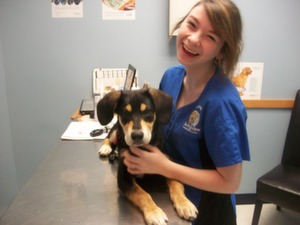Puppy House Training 101 – by Jeff Goodall, Veterinarian, Sunnyview Animal Care
Always remember we need to reward good behaviour with lots of praise and petting – treats are not always needed. Many dogs with this program will housetrain within a few weeks – No kidding! We use these tricks here at Sunnyview with great success. A few days or weeks of extra attention is a small discomfort for you & your puppy in order to get this part of training finished. You will both learn your puppies’ habits and, bond you & your family to your puppy quickly!
Things you will need:
- A Dog Carrier/Crate
- Timer
- Pick a place outside for your puppy to consistently use for relieving themselves
- Leash
- Cat Treats (You’ll see – read on!)
- Bell & strong cord (if you want to train your pup to tell you when he or she needs to go outside)
1) First start with the Carrier – it needs to be large enough for your puppy to stand up in, turn around, and lie somewhat stretched out. Where you place it is up to you, but be prepared for some crying for the first few nights – and don’t reward the crying that might happen for the first few nights. You puppy needs to be left in this carrier for the night and, anytime you go out whenever possible.
Confining your puppy to a room with a tile/linoleum floor for house training sounds like a great idea – but the smaller confines of the carrier use your puppies’ innate desire not to soil their ‘nest’ or home. Also, many times we see puppies for ingestion of baseboard or other items (including the flooring sometimes) that happen in these small rooms.
There is an exception to not using the crate for training – shelter or rescue dogs likely have had experience with not begin taken out as often as needed, and therefore the need not to soil where they live & sleep has been lost. Then use the room, covered in paper if possible when you go out, so you do not have to continually bathe & clean your dog anytime they would soil in a smaller crate. Towels or ‘Pee Pads’ are discouraged for this use, as your puppy may find them a tempting chew toy.
Aside – The general rule for how long you can leave your puppy unattended in their crate without an accident is their age in months, plus 1 – converted to hours. Therefore a 2 month old pup can be left and expected not to have an accident for 3 hours.
For the size of the crate – it should be just larger then the puppy itself, with enough room to stand up, turn around and, lie down with their legs tucked under themselves. Many ‘handy’ clients buy a larger crate and build a sturdy dividing wall that the puppy cannot chew nor get around – securing it firmly to the sides in the process. Then it is moved as the puppy grows. Too large a crate is just a bad as using a large room for training!
2) Next, buy an inexpensive kitchen timer or two – you will use this to train yourself and your family to remember to let your puppy out.
3) Pick a place away from your house for your puppy to use for deification and urination. Ideally, you will be able to leave a stool or two there for the first few days to a week, so your puppy knows its his or her ‘safe spot’ to use.
In general, the use of ‘Pee Pads’ in the home is not a great idea – your puppy will likely become confused & extend the house training period. Also, the same goes for training your puppy to use the back deck. We have had owners who train their puppy to use ‘Pee Pads’ while they are living in an apartment building, only to have significant challenges in re-training their adult dog once they move into a home later in their lives together.
4) Set a schedule for feeding & set your puppies’ schedule. Puppies under 12 weeks of age should be fed 3 times a day and, we can use this to our advantage for housetraining! Place the food down for 10-15 minutes to encourage them to get into a habit to eat regularly – and then leash your puppy to you and expect that they will need to relieve themselves within 15 minutes of eating. Watch for your puppies’ signs of wanting to go – sniffing, trying to hide, vocalizing, etc.
Aside – remember to wiggle your fingers in your puppies’ food while they eat so they understand not to become possessive of their food – encourage all members of your family to do so, and in a week or so, a friend or two that are visiting at feeding time. Also, use the feeding opportunity to “bait” your puppy into a sit position by lifting the bowl over their nose. Some of the more exuberant puppies will struggle with this for the first few days – feeding time is a happy time!
5) Set a schedule for yourself and your family – anticipate that your puppy will need to ‘go’ as soon as you wake up in the morning, within 15 minutes of eating, and likely anytime after playing. You will need to be aggressive in taking your puppy outside every 30 minutes for the first week when anyone is home with your puppy.
6) Get your puppy to the door ‘on time’ – First, for this to work most effectively, pick one door in the home to use. Second, at this door, have your coat, umbrella, your puppies’ lead, and cat treats handy so that when the timer goes off – there is no wasted time in getting outside. This applies to apartment dwellers as well.
7) Set the timer – for 15 minutes after eating, and for 30 minutes whenever you are home. Every time the timer goes off, pick your puppy up and get them to the door. Encourage your puppy to ‘sit’ and try to engage them with eye contact while you get your coat on & get ready. Carry your puppy to the spot you want them to ‘favour’ over others – we cannot stress this any more fully – walking your puppy to their spot just won’t work for a few months.
Wait for 3-5 minutes – possibly longer for the first few days, while your puppy comes to understand what is expected of them. When they go – a lot of praise (alot!) and, a cat treat or two – dogs love them!, and a good quality one will be low in calories, no additives or food colouring. Remember to just use this treat for house training however.
Aside – a lot of verbal praise and, repeating the words ‘Pee’ or ‘Outside’ or whatever word you are most comfortable with – and consistently use that word as your puppy relieves themselves, setting up word & action association. The more excited you sound – the more the puppy will be excited to please you!
Once you learn your puppies’ schedule for relieving themselves – you can cut the time down that they are outside. IF you have been walking for more then 5 minutes and, its clear your puppy does not need to go outside, thats ok. Just scoop them up and, carry them back in the home – don’t forget to RESET the timer!
8) What if your puppy does not go when you expected them too(?), or its been the 3rd or 4th time you have taken them out to pee and, they keep getting distracted? This is the time to leash them to yourself and, reset the timer for another 30 minutes. Don’t allow your puppy to fail – and they won’t.
Also, in the first week or two, it is a great idea to get up with your puppy twice nightly in the first few weeks to have your puppy relieve themselves and, then once nightly for the next few weeks as well. Feeding your puppy 3 hours or more before bedtime will allow them to sleep through the night, but don’t try this right away – use the opportunity of their need to go in the middle of the night to your advantage! Carry your puppy to the door, have them sit, carry them to their spot – and lots of reward words and treats!
People at coffee parties will be envious of your ability to train your puppy in less then 3 weeks!
Bell Training – once your puppy is through the first 3-4 weeks of training, your puppy is starting to hold out for more then an hour – and you are working on your puppy socialization classes with a reputable trainer, you can also look at working with your puppy to tell you when they need to go and avoid the timer.
Get a good sized Christmas or Bear Bell and, some very stout rope. Tie the bell to the door handle of the door you have trained them to just slightly above the level of their nose.
Anytime your timer goes off, walk to the door (likely puppy will be too) and call the puppy in your happiest voice. This will trigger their excitement to get to the door. Have the puppy sit as usual, and get your coat on (& umbrella as it seems to always rain during training) and, just before you open the door – hit the bell and use the keyword associated with the process. I.E. “Puppy want to go Pee?”, and hit the bell. Soon with consistent repetition, your puppy will be nosing the bell for you – the key will be to listen for it!
The Team at Sunnyview Animal Care hopes this helps you and your puppy get started on your journey together in the best possible way!

 (from a Scan from EpiOtic Cleaning information 2001)
(from a Scan from EpiOtic Cleaning information 2001)




